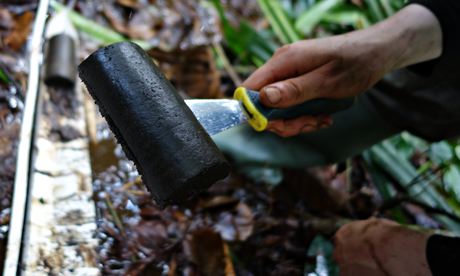Breakthrough in unlocking secrets of the Congo- Brazzaville basin and climate change.
Peat bog as big as England found in Congo-Brazzaville
Swamp thought to contain billions of tonnes of peat dating back 10,000 years will offer window on Africa's past, say experts.

Scientists say investigating the carbon-rich material could shed light on 10,000 years of environmental change in the region. Photograph: Simon Lewis
For peat's sake, a British scientist trekked for three weeks through perilous jungle swamps in one of the most far-flung corners of Africa. His reward? A peat bog the size of England.
But while some explorers might have found this anti-climactic, for Simon Lewis it was like striking gold. His discovery is being hailed by experts as a breakthrough in unlocking secrets of the Congo basin and climate change.
The monster swamp in Congo-Brazzaville is thought to contain billions of tonnes of peat dating back 10,000 years. Studies of this carbon-rich material could reveal how the environment has changed over millennia in central Africa – information that has remained largely shrouded in mystery due to political instability and the geographical remoteness.
The vast peatland was first detected by satellites, prompting Lewis, a researcher at the University of Leeds, to lead a scientific expedition last month from Itanga village in to one of the world's biggest wetlands which, because of its inaccessibility to outsiders, also has one of the biggest concentrations of gorillas and elephants. People can only wade into the bog two or three months a year, at the end of the dry season, said Lewis. Even so, to avoid getting soaked, his team had to build a platform each time they wanted to pitch tents and cook food.
Along the way their guide encountered a gorilla, while on a couple of nights a herd of elephants thundered past the camp. Crocodiles were also a potential danger.
"It is very remote," Lewis said on Monday. "If things go wrong, it could be hard to get everyone and take them to hospital."
But for the academic and his fellow researchers from the University of Leeds, the Wildlife Conservation Society-Congo, and Congo-Brazzaville's Marien Ngouabi University, it was all worthwhile when they identified the bog spanning 40,000 to 80,000 square miles, its peat layer up to 23ft (seven metres) deep.
The discovery illustrates how relatively little is still known about some of Africa's most remote and inhospitable environments. Lewis said: "To me it's quite amazing that there are still uncharted places. This is a peatland something like the size of England."
Peat arises from partly decomposed plant material and builds up in waterlogged conditions. The researchers believe this bog holds billions of tonnes of partially decayed vegetation and large quantities of carbon. The team took samples of the peat back to the UK for scientific analysis.
Lewis said: "The Congo peatland is a major store of carbon, slowly removing carbon from the atmosphere. This should, if the region is not drained for agricultural use, store billions of tonnes of carbon for the long term, keeping it out of the atmosphere.
"Additionally, as peat develops it [retains concurrent] environmental conditions so can provide a window on the past. Pollen captured as the peat forms can be linked to the vegetation [of the] time.
This is important for the central Congo basin region as so little is known about the region, either today or in the past."
He added: "Understanding past vegetation and climatic changes can help scientists make robust assessments of how the climate will likely change in the future and how that will [affect] the swamp forest and peat."
Peatlands cover less than 3% of the land surface of the Earth but are believed to contain twice as much carbon as the world's forests.
Fellow scientists said Lewis's discovery would offer fresh insights into the environmental history of the Congo basin and its role in the global climate. This could have implications for predicting and mitigating climate change.
Mike Meadows, head of environmental and geographical science at the University of Cape Town, South Africa, said it was the historic knowledge gap in Africa's vegetation that first inspired him to pursue a career in the subject.
"What's really interesting is so far how little has been studied," he said. "We know very little about rainforest history. If you had a map of Africa and sites where we know something about the last 10-20,000 years, there would be pretty much a blank space over most of the Congo basin."
He added: "The size of this is extraordinary: one of the largest peatlands in Africa, and possibly the world. I'm very jealous that I wasn't involved in this, although getting my feet wet for three weeks doesn't appeal so much."
Jasper Knight, senior lecturer in physical geography at Wits University, in Johannesburg, said: "It's certainly very significant because peat bogs contain a very detailed record of climate and environmental change. It's a part of the world that we know little about today. This will fill in a very big piece of the jigsaw of our understanding of climate and environmental change over the past 10,000 years."



Comments
Post a Comment